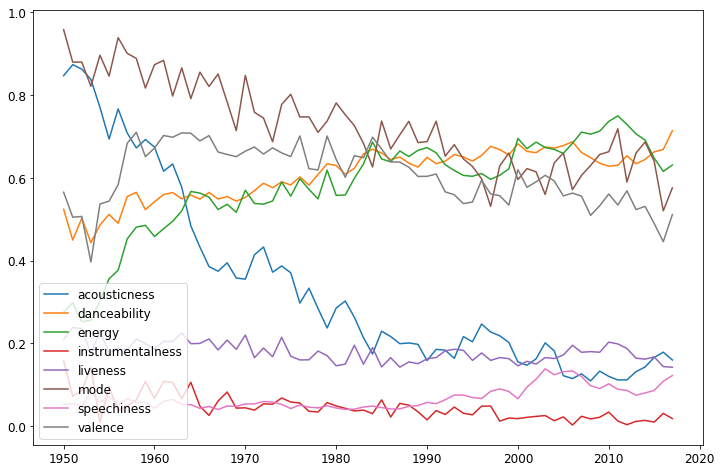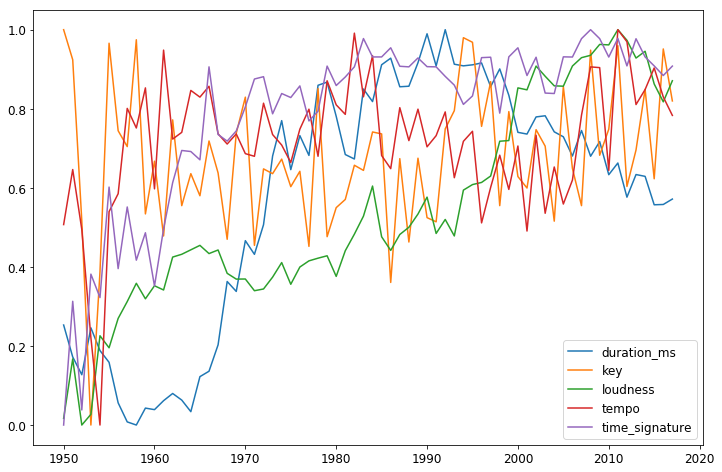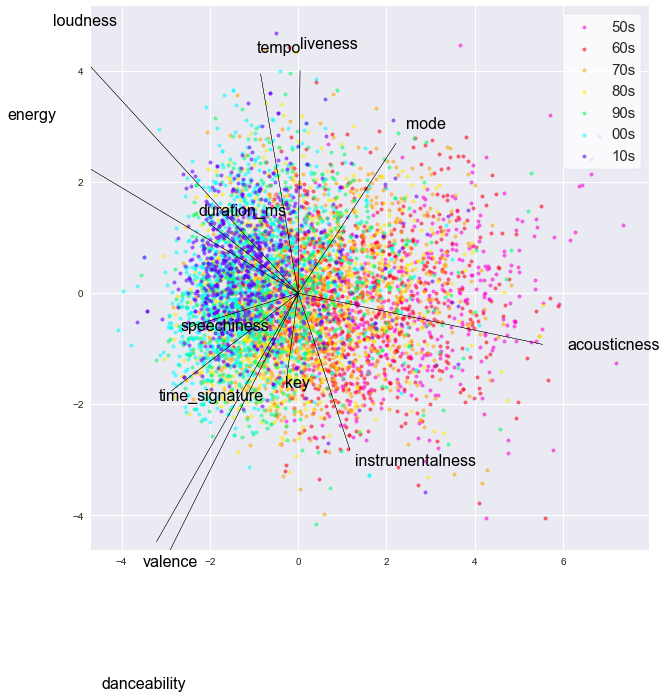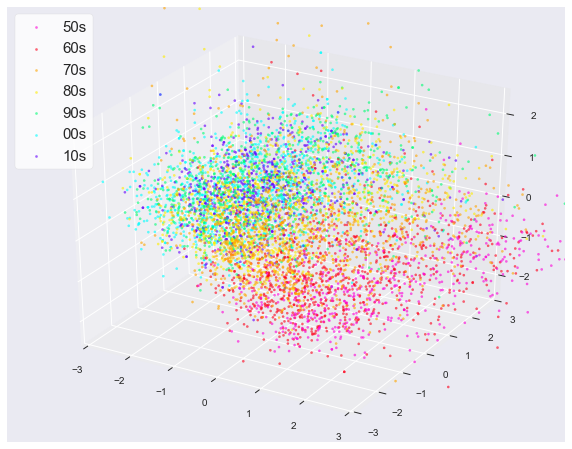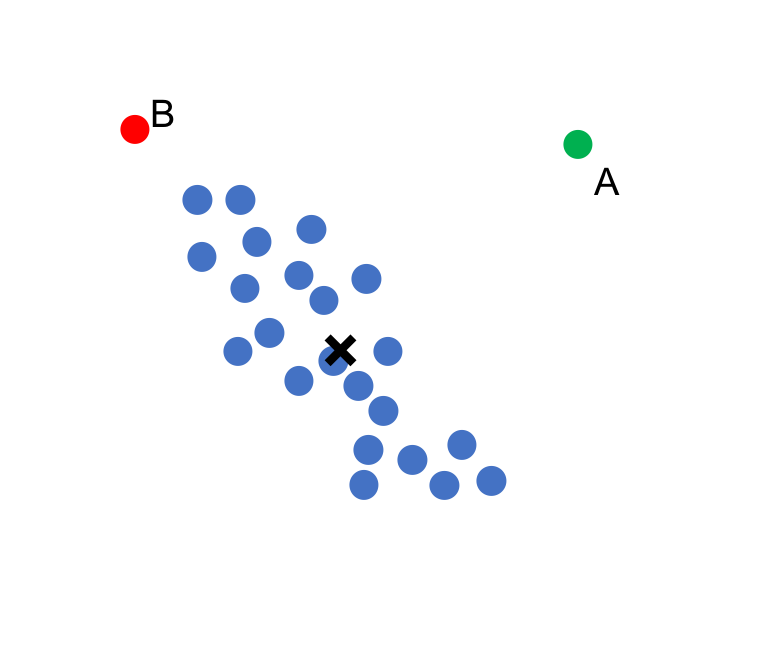はじめに
私は音楽鑑賞が趣味で, 大学ではビルボード研究会というサークルに入っているのですが, 不真面目な部員なのでビルボードチャートをチェックするのは年に数回で, 自分の好きな音楽ばかり聴いています.
「たまにはビルボードを研究しなければ」と思い立ったので, Pythonを使ってデータ解析的な研究をしてみることにしました.
全体としては,
- Billboard Year-End Hot 100のリストを1950年から2017年まで取得する
- 1のリストの全曲についてSpotifyが公開しているAudio Featuresを取得する
- データを観察する
- 主成分分析で次元削減してプロットする
- 各曲を年代ごとにグループ分けして, 各グループで重心から最も近いものを調べる
という流れで進めていきます.
アルゴリズムやコードの解説もしながら進めていくので, 結果が気になる人は最後まで飛ばしてください.
データの用意
Billboard Year-End Hot 100
ビルボードは1950年から継続的に, 1年間で最も流行した曲のランキングを作っています.
当初の評価基準はレコードの売上枚数でしたが, その後の視聴形態の変化に合わせてCD売上枚数, ダウンロード数, ストリーミング再生数なども比較的柔軟に加味しているため, その年の流行をよく反映していると考えられます.
なお, 100曲選ばれたのは1959年からで, 1950年から1955年の間は30曲, 1956年から1958年までは50曲のみが選ばれました.
公式サイトはこちらですが, ほとんど遡ることができません.
データベースやAPIのようなものもなさそうなので, 『ウェブスクレイピングで77年分のビルボード年間トップ100を取得してみた. - ただの風邪. 』を参考に, 非公式サイト『Billboard Top 100 Songs of Every Year』から取得しました. 非公式なので正確性は保証できません.
こちらが実行したコードです.
import requests, csv
from bs4 import BeautifulSoup
from time import sleep
for year in range(1945,2018):
print(year)
# その年のチャートにアクセスしてランキング部分を取り出す
url = "http://billboardtop100of.com/" + str(year) + "-2/"
r = requests.get(url)
soup = BeautifulSoup(r.content, "html.parser")
items = soup.find_all("td")
# ランキングをリストにまとめる
# カンマはcsvの区切り文字に使うので消去
chart = [["rank", "artist name", "song title"]]
for i, item in enumerate(items):
if i % 3 == 0:
chart.append([items[i].text,
items[i + 1].text.replace(",",""),
items[i + 2].text.replace(",","")])
# CSVファイルに保存
with open('../billboard_csv/' + str(year) + '.csv', 'w', encoding='utf-8') as f:
writer = csv.writer(f, lineterminator='\n')
writer.writerows(chart)
# サーバに負荷をかけすぎないように, 必ず入れてください
sleep(5)
失敗した分(確か2013年)や足りない分(2017年)はWikipediaから手動で取りました.
最初からWikipediaからスクレイピングすれば良かったような気もしますが, ページごとに仕様が統一されていなかったり, 更新が頻繁だったりするとコードが使えないという問題があります.
ともあれ, これで計6230曲が集まりました.
Spotify Audio Features
次にこのデータの特徴量をSpotify Web APIを使って取得します.
まずはSpotify for Developersでアカウント登録し, アプリケーションを作ってClient IDとClient Secretを控えてください.
次にAPIを利用するためのライブラリspotipyをインストールします.
$ pip install spotipy
APIを使う前に, 特徴量として利用するAudio Featuresについて説明します.
レファレンスを日本語でまとめてみました.
| 名前 | 型 | 説明 |
|---|---|---|
| acousticness | float | どれだけアコースティックか. 0.0-1.0 |
| danceability | float | テンポ, リズムの定常性, ビート強度の複合指標. 0.0-1.0 |
| duration_ms | int | トラックの長さ |
| energy | float | 感覚的な音の強さ. 0.0-1.0 |
| instrumentalness | float | ボーカルが少なければ1.0, 多ければ0.0 |
| key | int | キーを整数に直したもの. 例えばCが0 |
| liveness | float | 音源に聴衆の音が含まれている度合い. 0.0-1.0 |
| loudness | float | 音圧レベル[dB]. -60.0-0.0 |
| mode | int | メジャーなら1, マイナーなら0 |
| speechiness | float | どれだけスピーチに近いか. 0.0-1.0 |
| tempo | float | Beats Per Minute |
| time_signature | int | 拍子. 1小節の中の拍の数 |
| valence | float | ポジティブさ. 0.0-1.0 |
以上の13特徴量を利用します.
duration_msやloudnessのように定義が明確なものもあれば, acousticnessやvalenceのようにSpotify独自の指標もありますね.
Spotifyはこれらを使ってレコメンドなどを行っているのだと思いますが, 内部のデータを公開してくれるのはありがたいです.
さて, 特徴量取得の流れとしては,
- ビルボードチャートの曲名とアーティスト名のクエリをSpotifyに送り, 曲のIDを受け取る
- IDをSpotifyに送り, 曲の特徴量を受け取る
という2段階になります. これをまたCSVファイルにまとめます.
*私はClient IDとClient Secretを.envに保存しました
import pandas as pd
import re
from tqdm import tqdm
import time
import spotipy
from spotipy.oauth2 import SpotifyClientCredentials
class SpotifyMethods:
@classmethod
def __init__(self):
with open("./.env") as f:
data = f.readlines()
client_id = data[0][data[0].find("'")+1:-2]
client_secret = data[1][data[1].find("'")+1:-2]
credentials_manager = SpotifyClientCredentials(client_id, client_secret)
self.sp = spotipy.Spotify(client_credentials_manager=credentials_manager)
# dataframeに含まれる曲のIDを取得する
@classmethod
def getID(self, dataframe):
ids = []
for i in range(len(dataframe)):
query = transform(dataframe.iloc[i]["artist name"]) + " " + transform(dataframe.iloc[i]["song title"])
results = self.sp.search(q=query, type='track', limit=1)
if len(results["tracks"]["items"])>0:
track_id = results['tracks']['items'][0]["id"]
else:
track_id = None
ids.append(track_id)
time.sleep(1) # 必ず入れる
return ids
# 曲名とアーティスト名から記号や"feat"以下などを取り除く
def transform(string):
l = string.lower().replace(".", "").replace("&", "").replace("-", " ").split(" ")
if "featuring" in l:
l = l[:l.index("featuring")]
if "feat" in l:
l = l[:l.index("feat")]
return " ".join(l)
def main():
sm = SpotifyMethods()
df_all = pd.DataFrame(index=[], columns=['rank', 'artist name', 'song title', 'id', 'year', 'danceability',
'energy', 'key', 'loudness', 'mode', 'speechiness', 'acousticness',
'instrumentalness', 'liveness', 'valence', 'tempo', 'type', 'uri',
'track_href', 'analysis_url', 'duration_ms', 'time_signature',
'decade'])
sr_none = pd.Series([None]*len(df_all.columns), index=df_all.columns)
for year in range(1950,1950):
df = pd.read_csv("../spotify_csv/"+str(year)+".csv")
df_all = df_all.append(df, ignore_index=True)
for year in tqdm(range(1950,2018)):
df = pd.read_csv("../billboard_csv/"+str(year)+".csv")
df["year"] = year
df["decade"] = (df["year"]-1900)//10
df["id"] = sm.getID(df) # IDを取得
df = df.dropna() # 欠損値のある行を取り除く
features = sm.sp.audio_features(df["id"].values) # 特徴量を取得
for i in range(len(features)):
if features[i] is None:
features[i] = sr_none
keys = features[0].keys()
for key in keys:
df[key] = [features[i][key] for i in range(len(features))]
df = df.dropna() # 欠損値のある行を取り除く
print(year, len(df))
df.to_csv("../spotify_csv/"+str(year)+".csv", sep=",", index=False)
df_all.append(df, ignore_index=True)
df_all.to_csv("../spotify_csv/all.csv", sep=",", index=False)
print(len(df_all), "tracks in total")
if __name__ == "__main__":
main()
クエリを作るところは少し注意が必要です.
例えば, transform関数で全ての記号を削除してしまうと"Ke$ha"が"Keha"となってしまいIDが見つかりません.
また, featuringのアーティストをたくさん入れすぎると, これもIDが見つからない原因になります.
落とし所として, "featuring"以下や".", "&", "-"を消すことにしましたが, もっと良い処理があるかもしれません. 曲名の中の"()"は消すべきだったかもしれません.
欠損値を除いて最終的に特徴量が得られたのは全体で6112曲分(98.1%)でした.
ただし, これも全て意図した曲のIDが取れているとは限りません. 曲名が同じでもカラオケ音源などややこしいものが混ざっている可能性があります(面倒なので確認しませんでした).
結果はこちらで公開しています.
データの可視化
*ここからはJupyter Notebookで分析しました.
必要なライブラリをインポートしてください.
import numpy as np
import pandas as pd
from matplotlib import pyplot as plt
from sklearn.preprocessing import StandardScaler
from sklearn.decomposition import PCA
from mpl_toolkits.mplot3d import Axes3D
得られたデータのうち, 値が0から1に固定されているものを年ごとに平均してプロットしてみました.
danceabilityとenergyが増加している一方, acousticnessとmodeが減少しています.
danceability, energy, acousticnessに関しては電子楽器の発達やEDMの流行と関係がありそうです.
modeの減少はマイナー調のヒット曲が増えたことを示していますが, この傾向があるとは知りませんでした.
また, よく見るとspeechinessがじわじわと上がっていますが, これはラップの流行によるものでしょう.
*ラップのspeechinessは0.5程度ですが, 他のジャンルの音楽で概ね0.1以下であるのに比べると大きいと言えます
次に, 残りのデータを0から1に収まるように正規化してプロットしてみました.
loudnessとtime_signatureが増加しています.
duration_msは1993年頃をピークに減少しています.
主成分分析
主成分分析(promary component analysis; PCA)という手法を使って次元削減を行うと, 13個の特徴量を一目で見ることができます.
今, 各曲は13本の軸を持つ13次元空間上にある点だと考えます.
PCAによる次元削減は, これらの点の分散(広がり)が最も大きくなるような位置から光を当ててその影を見ているというイメージです.
計算方法が気になる方は, このPDFあたりをご覧ください.
第2主成分までを元の軸とともにプロットしたコードと図がこちらです.
def byplot2d(dataframe, arrow_mul=1, text_mul=1.1):
ss = StandardScaler()
X = ss.fit_transform(dataframe.drop(["decade"], axis=1).values)
feature_names = dataframe.drop(["decade"], axis=1).columns
pca = PCA(n_components=2)
X = pca.fit_transform(X)
pc0 = pca.components_[0]
pc1 = pca.components_[1]
plt.figure(figsize=(10,10))
colors = ['#FF00D9', '#FF001A', '#FFA500', '#FFED00', '#00FF75', '#00FFFF', '#6500FF']
labels = ['50s', '60s', '70s', '80s', '90s', '00s', '10s']
st = 0
for dec in range(5,12):
ed = st+len(df_all.loc[df_all["decade"]==dec])
plt.scatter(X[st:ed,0], X[st:ed,1],
c=colors[dec-5], marker=".", alpha=0.6, label=labels[dec-5])
st = ed
plt.legend(fontsize=15, loc='upper right', frameon=True, facecolor="white")
print('各次元の寄与率: {0}'.format(pca.explained_variance_ratio_))
print('累積寄与率: {0}'.format(sum(pca.explained_variance_ratio_)))
for i in range(pc0.shape[0]):
plt.arrow(0, 0,
pc0[i]*arrow_mul, pc1[i]*arrow_mul,
color='black')
plt.text(pc0[i]*arrow_mul*text_mul,
pc1[i]*arrow_mul*text_mul,
feature_names[i],
color='black', fontsize=16)
plt.show()
byplot2d(df.drop(["artist name", "song title", "rank", "year"], axis=1), arrow_mul=12)
時代が進むにつれて点群がグラフ上を右から左に移動しているのがわかります.
この動きに対応する軸は, acousticness, loudness, energy, duration_msあたりです.
第3主成分までをプロットしたコードと図がこちらです.
def byplot3d(dataframe):
ss = StandardScaler()
X = ss.fit_transform(dataframe.drop(["decade"], axis=1).values)
pca = PCA(n_components=3)
X = pca.fit_transform(X)
fig = plt.figure(figsize=(10,8))
ax = fig.add_subplot(111, projection='3d')
colors = ['#FF00D9', '#FF001A', '#FFA500', '#FFED00', '#00FF75', '#00FFFF', '#6500FF']
labels = ['50s', '60s', '70s', '80s', '90s', '00s', '10s']
st = 0
for dec in range(5,12):
ed = st+len(df_all.loc[df_all["decade"]==dec])
ax.scatter(X[st:ed,0], X[st:ed,1], X[st:ed,2],
c=colors[dec-5], marker=".", alpha=0.6, label=labels[dec-5])
st = ed
ax.set_xlim(-3, 3)
ax.set_ylim(-3, 3)
ax.set_zlim(-2.5, 2.5)
plt.legend(fontsize=15, loc='upper left', frameon=True, facecolor="white")
plt.show()
print('各次元の寄与率: {0}'.format(pca.explained_variance_ratio_))
print('累積寄与率: {0}'.format(sum(pca.explained_variance_ratio_)))
byplot3d(df.drop(["artist name", "song title", "rank", "year"], axis=1))
綺麗な図が書けて満足です.
「代表する曲」の検討
各年代グループの重心から近い曲を調べてみましょう.
「近さ」を測る指標としては, 普段から馴染深いユークリッド距離ではなく, 分布の歪みを考慮したマハラノビス距離を使います.
下図の例でいうと, 青い点群の重心から点A, Bまでのユークリッド距離は等しいですが, 点群の分布の形を考えるとBよりも, Aの方が遠くなってほしいですよね. こういう状況ではマハラノビス距離が役に立ちます.
点群の重心のベクトル(列ベクトル)を$\mu$, 点Xのベクトルを$x$とすると, ユークリッド距離は以下のように定義されます.
d_E = \sqrt{(x-\mu)^T(x-\mu)}
一方, マハラノビス距離は, 点群の各次元の分散共分散行列$\Sigma$を用いて次のように定義されます.
d_M = \sqrt{(x-\mu)^T \Sigma^{-1}(x-\mu)}
詳しくは, 『教師なし学習による異常値検知(1): マハラノビス距離 - 未来永劫』あたりがわかりやすいです.
以下の実装では, 複数の曲に対するマハラノビス距離(の二乗)を行列で一気に計算し, 距離の最も短い10曲を出力しています.
st = 0
X = ss.fit_transform(df.drop(["artist name", "song title", "rank", "decade", "year"], axis=1).values)
for dec in range(5,12):
ed = st+len(df_all.loc[df_all["decade"]==dec])
Xdec = X[st:ed,:]
Xdec_mean = np.mean(Xdec, axis=0)
cov = np.cov(Xdec.T)
distances = np.diag(np.dot(np.dot(Xdec, np.linalg.inv(cov)), Xdec.T)) # 距離の2乗
print(distances.shape)
i_mins = np.argsort(distances)[:10]
val_mins = distances[i_mins]
print("\nDecade:", dec)
for i in range(10):
song = df.loc[st+i_mins[i],["song title"]].values[0]
artist = df.loc[st+i_mins[i],["artist name"]].values[0]
val = round(val_mins[i],2)
year = df.loc[st+i_mins[i],["year"]].values[0]
rank = df.loc[st+i_mins[i],["rank"]].values[0]
print("|", i+1, "|", song, "|", artist, "|", val, "|", year, "|", rank, "|")
st = ed
結果発表!
1950年代
| 順位 | 曲名 | アーティスト | 距離 | 年 | ランク |
|---|---|---|---|---|---|
| 1 | The Banana Boat Song | Tarriers | 6.68 | 1957 | 26 |
| 2 | Poison Ivy | Coasters | 10.07 | 1959 | 54 |
| 3 | Lazy Mary | Lou Monte | 10.36 | 1958 | 80 |
| 4 | Shake Rattle And Roll | Bill Haley and His Comets | 11.95 | 1954 | 26 |
| 5 | Be-bop-a-lula | Gene Vincent | 12.67 | 1956 | 27 |
| 6 | At The Hop | Danny and The Juniors | 13.02 | 1958 | 20 |
| 7 | Sea Cruise | Frankie Ford | 13.12 | 1959 | 89 |
| 8 | Alvin’s Harmonica | David Seville and The Chipmunks | 13.36 | 1959 | 48 |
| 9 | Rock-a-Bye Your Baby with a Dixie Melody | Jerry Lewis | 13.39 | 1957 | 64 |
| 10 | Witch Doctor | David Seville | 13.45 | 1958 | 4 |
Beatles以前はよくわかりません…
1960年代
| 順位 | 曲名 | アーティスト | 距離 | 年 | ランク |
|---|---|---|---|---|---|
| 1 | Hungry | Paul Revere and The Raiders | 1.93 | 1966 | 97 |
| 2 | I Got The Feelin’ | James Brown and The Famous Flames | 3.91 | 1968 | 58 |
| 3 | San Francisco | Scott Mckenzie | 4.04 | 1967 | 48 |
| 4 | We Gotta Get Out Of This Place | Animals | 4.63 | 1965 | 86 |
| 5 | Polk Salad Annie | Tony Joe White | 4.78 | 1969 | 77 |
| 6 | Windy | Association | 4.81 | 1967 | 4 |
| 7 | Sunshine Superman | Donovan | 4.82 | 1966 | 26 |
| 8 | It’s Now Or Never | Elvis Presley | 4.93 | 1960 | 7 |
| 9 | It Hurts To Be In Love | Gene Pitney | 4.96 | 1964 | 27 |
| 10 | Mr. Sun Mr. Moon | Paul Revere and The Raiders | 5.02 | 1969 | 95 |
60年代らしく、クラシックロックと称されるジャンルの曲が多いです。
1970年代
| 順位 | 曲名 | アーティスト | 距離 | 年 | ランク |
|---|---|---|---|---|---|
| 1 | You’re No Good | Linda Ronstadt | 2.7 | 1975 | 50 |
| 2 | Loves Me Like A Rock | Paul Simon | 2.76 | 1973 | 27 |
| 3 | Make Me Smile | Chicago | 2.88 | 1970 | 59 |
| 4 | Undercover Angel | Alan O’Day | 3.35 | 1977 | 9 |
| 5 | Get Down Get Down (Get On The Floor) | Joe Simon | 3.39 | 1975 | 76 |
| 6 | How Much I Feel | Ambrosia | 3.56 | 1979 | 84 |
| 7 | Dazz | Brick | 3.57 | 1977 | 41 |
| 8 | Rock Me Gently | Andy Kim | 3.64 | 1974 | 29 |
| 9 | Hot Child In The City | Nick Gilder | 3.65 | 1978 | 22 |
| 10 | My Maria | B.W. Stevenson | 3.72 | 1973 | 64 |
1980年代
| 順位 | 曲名 | アーティスト | 距離 | 年 | ランク |
|---|---|---|---|---|---|
| 1 | (Keep Feeling) Fascination | Human League | 3.75 | 1983 | 33 |
| 2 | Penny Lover | Lionel Richie | 4.35 | 1985 | 96 |
| 3 | Ebony And Ivory | Paul McCartney and Stevie Wonder | 4.51 | 1982 | 4 |
| 4 | Our House | Madness | 4.88 | 1983 | 53 |
| 5 | Open Your Heart | Madonna | 4.93 | 1987 | 30 |
| 6 | Express Yourself | Madonna | 4.94 | 1989 | 55 |
| 7 | California Girls | David Lee Roth | 4.99 | 1985 | 88 |
| 8 | Real Love | Jody Watley | 5.28 | 1989 | 46 |
| 9 | 867-5309 (Jenny) | Tommy Tutone | 5.35 | 1982 | 16 |
| 10 | Coward Of The County | Kenny Rogers | 5.48 | 1980 | 34 |
これはしっくりくる結果ですね!
1990年代
| 順位 | 曲名 | アーティスト | 距離 | 年 | ランク |
|---|---|---|---|---|---|
| 1 | Dreamlover | Mariah Carey | 2.56 | 1993 | 8 |
| 2 | Place In This World | Michael W. Smith | 2.83 | 1991 | 77 |
| 3 | Last Kiss | Pearl Jam | 2.84 | 1999 | 23 |
| 4 | Uhh Ahh | Boyz II Men | 2.84 | 1992 | 84 |
| 5 | 2 Become 1 | Spice Girls | 2.95 | 1997 | 35 |
| 6 | Fantasy | Mariah Carey | 3.13 | 1995 | 7 |
| 7 | Back For Good | Take That | 3.17 | 1995 | 62 |
| 8 | Everyday Is A Winding Road | Sheryl Crow | 3.48 | 1997 | 60 |
| 9 | Joyride | Roxette | 3.55 | 1991 | 23 |
| 10 | It’s Your Love | Tim McGraw and Faith Hill | 3.68 | 1997 | 40 |
2000年代
| 順位 | 曲名 | アーティスト | 距離 | 年 | ランク |
|---|---|---|---|---|---|
| 1 | No Shoes No Shirt No Problems | Kenny Chesney | 2.85 | 2003 | 91 |
| 2 | The Good Stuff | Kenny Chesney | 3.17 | 2002 | 82 |
| 3 | Here (In Your Arms) | Hellogoodbye | 4.01 | 2007 | 81 |
| 4 | Living and Living Well | George Strait | 4.18 | 2002 | 93 |
| 5 | Fallin’ For You | Colbie Caillat | 4.22 | 2009 | 68 |
| 6 | TRUE | Ryan Cabrera | 4.29 | 2005 | 90 |
| 7 | You’ll Think of Me | Keith Urban | 4.31 | 2004 | 93 |
| 8 | Let Me Love You | Mario | 4.38 | 2005 | 3 |
| 9 | Beer for my Horses | Toby Keith Duet With Willie Nelson | 4.74 | 2003 | 75 |
| 10 | I Don’t Want to Be | Gavin DeGraw | 4.83 | 2005 | 58 |
Kenny Chesneyというカントリー歌手が1位と2位になりました.
2000年代はカントリーが流行っていたのでしょうか…?
2010年代
| 順位 | 曲名 | アーティスト | 距離 | 年 | ランク |
|---|---|---|---|---|---|
| 1 | Good Life | OneRepublic | 4.11 | 2011 | 25 |
| 2 | Knee Deep | Zac Brown Band feat. Jimmy Buffett | 4.33 | 2011 | 80 |
| 3 | Wildest Dreams | Taylor Swift | 4.73 | 2015 | 57 |
| 4 | Burnin’ It Down | Jason Aldean | 5.01 | 2014 | 63 |
| 5 | Gone Gone Gone | Phillip Phillips | 5.09 | 2013 | 61 |
| 6 | Pompeii | Bastille | 5.21 | 2014 | 12 |
| 7 | 22 | Taylor Swift | 5.26 | 2013 | 71 |
| 8 | Team | Lorde | 5.34 | 2014 | 18 |
| 9 | Firework | Katy Perry | 5.58 | 2011 | 3 |
| 10 | You And Tequila | Kenny Chesney feat. Grace Potter | 5.71 | 2011 | 98 |
Taylor vs Katyの戦い, ここではTaylor勝利です.
「〇〇年代を代表しない曲」
ちなみに, 先ほどのコードでi_mins = np.argsort(distances)[:10]のインデックスの部分を[-10:]とすれば, 重心から最も遠い10曲を選べます.
結果を1曲ずつだけ紹介します.
| 年代 | 曲名 | アーティスト | 距離 | 年 | ランク |
|---|---|---|---|---|---|
| 50 | St. George And The Dragonet | Stan Freberg | 186.7 | 1953 | 15 |
| 60 | Delilah | Tom Jones | 83.7 | 1968 | 66 |
| 70 | Tubular Bells | Mike Oldfield | 259.65 | 1974 | 79 |
| 80 | A Love Bizarre | Sheila E. | 95.87 | 1986 | 83 |
| 90 | Now And Forever | Richard Marx | 170.21 | 1994 | 25 |
| 00 | Wanna Get To Know You | G-Unit feat. Joe | 189.21 | 2004 | 86 |
| 10 | Imma Be | Black Eyed Peas | 287.29 | 2010 | 20 |
全体的によくわからない結果です.
Tubular Bellsは, 収録時間が26分とduration_msが外れ値的に大きいです.
プレイリスト
知らない曲も多かったので, プレイリストにまとめてみました!
Songs That Defined X0's | Spotify
Songs That DID NOT Define X0's | Spotify
感想
やる前からわかってはいましたが, 結果の解釈が難しいですね…
「わかるような, わからないような」というのが正直な感想です.
ただ, 年間の売り上げや順位のような「人による評価」を利用しなかったため, 音楽メディアが選ぶ「〇〇年代を代表する曲」とは全く異なる結果が出ておもしろかったです.
